One of the hot buttons in retail financial services right now is the pending restrictions on credit card late fees finalized earlier this year by the Consumer Financial Protection Bureau (CFPB). The final rule, which does not apply to smaller issuers, is being litigated by the industry in federal court, after multiple legal machinations that have even seen jurisdiction swings from northern Texas to Washington, D.C., and back again.
During the first round of first quarter bank earnings briefings, representatives of the nation’s biggest banks reviewed credit card account openings and performance developments and analysts probed what they had to say. But curiously, only one analyst — Erika Najarian of UBS — asked one institution (Citigroup) about the credit card late fee rule’s impact. It’s a question many have been asking since the CFPB published the final rule — that, and how card issuers plan to handle the change in economics.
In brief, the new rule would hold large issuers to a maximum fee of $8, versus the industry’s typical charge of $32, unless they can demonstrate they need higher fees to cover their collection costs.
CFPB estimates the rule will save U.S. households $10 billion annually. That’s going to come out of somebody’s pocket.
In responding to the analyst’s question about the impact, Citigroup wasn’t willing to share a dollar figure, although officials said that the fee’s likely effects had already been factored into revenue projections for the year. Mark Mason, chief financial officer, added that the rule would likely take effect earlier than had originally been anticipated. (The rule amends existing “truth in lending” regulations; typically truth in lending changes take effect in October, but the rule is currently slated to be effective on May 14.)
Then Jane Fraser, Citi’s CEO, chimed in. She pointed out that across the company’s card portfolios, 85% of cardholders are prime — implying that late fees have not been as much of a factor. On the other hand, she said, the company runs Citi Retail Services (CRS), which includes one of the largest private label and co-branded card operations. Among that pool of cardholders, late fees are a more significant factor, according to Fraser, and the bank won’t absorb the rule’s impact by itself.
“The economics of the fee change will be shared with our partners in [Citi Retail Services],” said Fraser. “We want our customers to pay on time.” Fraser said the company had also been taking other steps to mitigate the impact of the new rule, though she provided no other details.
Credit Card Trends Among the Big Banks
On the broader subject of credit cards, banks and analysts expanded on a line of discussion that’s been going on since the pandemic’s aftermath began — the “normalization” of consumer credit usage and payment trends as the last bits of federal stimulus drain out of the system. The impact inflation on consumer spending trends was also discussed. Besides Citi’s presentation, The Financial Brand also reviewed presentations by JPMorgan Chase, Bank of America, Wells Fargo and U.S. Bancorp.
“Consumers remain financially healthy, supported by a resilient labor market. While cash buffers have largely normalized, balances are still above pre-pandemic levels and wages are keeping pace with inflation.”
— Jeremy Barnum, CFO, JPMorgan Chase
Barnum added that the overall consumer spending has been in line with 2023 levels.
Citi also discussed how trends that would have shown up sooner under normal circumstances have finally kicked in. The cost of providing consumer credit in general rose substantially over 2023 because of higher net credit losses.
“Card loan vintages that were originated over the last few years were delayed in their maturation due to the unprecedented levels of government stimulus during the pandemic and are now maturing,” Mark Mason, the CFO, told analysts. Mason also pointed out that the bank was keeping an eye on how unemployment, inflation and interest rates change going forward. Because of the lag described above, he said, the bank sees “multiple vintages maturing at the same time.”
Wells Fargo addressed another facet of the “vintages” issue. The bank has seen card charge offs rise, but indicated it was in line with expectations. CFO Mike Santomassimo pointed out that the company has been refreshing its credit card product line over three years.
“We’re seeing faster growth in new accounts and new balances coming on than other players,” Santomassimo said. “With that comes some maturation of the new vintages.” He said this was an expected pattern and that overall credit quality among the newer accounts was good. At some point, he said, charge offs “should peak and you’ll start to see more normal behavior.”
Cards Are Growth Source in a Down Market for Loan Growth
Overall, the big banks are seeing credit card balances grow, a bright spot in that it provides some loan growth in a period of slow loan growth overall. JPMorgan Chase, for example, expects card loan growth for the year to come to 12%.
Bank of America’s Alastair Borthwick, chief financial officer, was asked by an analyst when investors would see “a little bit more normal BofA loan growth and not have to wait two years for it.”
Borthwick said he thought renewed growth was close, while explaining what has prevented it thus far.
“We’re in that transition period where post-pandemic, the economy is sort of recovering and rates are settling in, and it’s changing people’s behavior,” he said. “We’ve actually got pretty good credit card growth, and that’s just offset by the fact that, for example, with securities-based lending at rates that are 5% higher, people are doing less of it. Or in commercial, we’ve got some loan growth, but the revolver utilization is still suppressed because revolver costs a lot more. As the Fed[eral Reserve] has raised rates, its changed some of the borrowing patterns of our clients.”
Chase Sees Differing Behavior Among Income Cohorts
At Chase, there’s been a growing stratification among customer income categories.
Overall, “consumer customers are fine. The unemployment rate is very low. Home prices are up, stock prices are up,” said Jamie Dimon, chairman and CEO at Chase. “The amount of income they need to service their debt is still kind of low. But the extra money of the lower-income folks is running out — not running out, but normalizing. And, of course, higher-income folks still have more money. They’re still spending it. ”
“For some real incomes are down, and they are struggling a little bit.”
— Jeremy Barnum, CFO, JPMorgan Chase
Barnum, Chase’s CFO, went further. He noted that among the lowest-income groups, while real income has gone up for many, “for some real incomes are down, and they are struggling a little bit.”
That said, many of those consumers have adjusted. “In the spending patterns among those people, there is some meaningful slowing, rather than what you might have feared, which is an aggressive levering up,” said Barnum. He said this was encouraging because it indicated that people were acting rationally and managing their own balance sheets.
“That’s good news from a credit perspective,” said Barnum.
U.S. Bancorp saw charge-offs rise in credit cards in the first quarter, driven primarily by credit cards, and expects to see more in the second quarter, according to Terry Dolan, vice chairman and administration officer. However, he expects charge-offs to move downward again.







